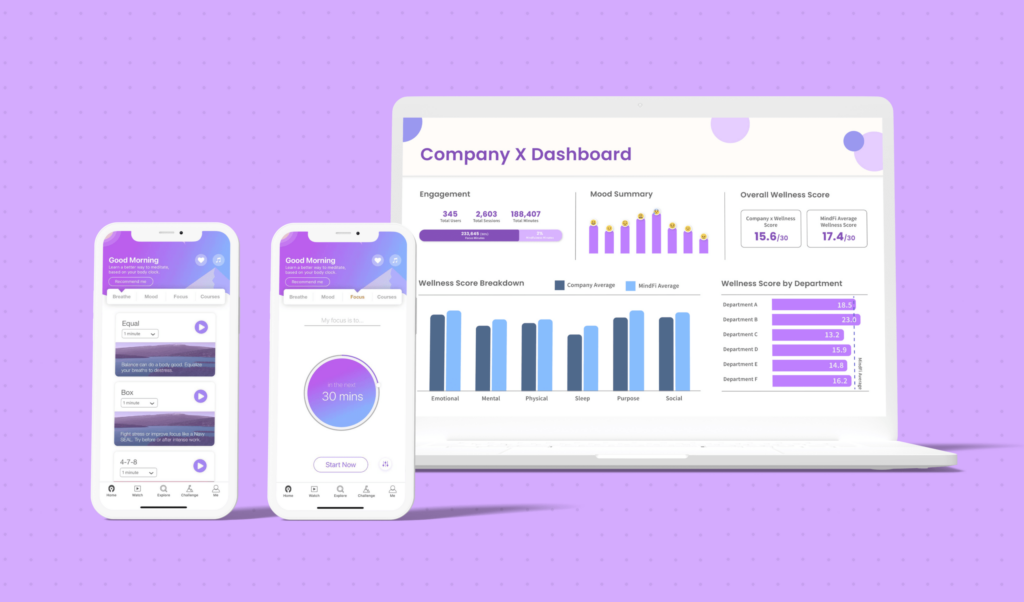Employee wellbeing is not just a nice-to-have; it’s a strategic imperative for businesses looking to thrive in today’s competitive landscape. But the matter is less straightforward in Asia, where stigma and cultural differences make it difficult for anyone to agree on what “wellbeing” for employees should look like. In the region, some may even argue that wellbeing is a personal, not a professional matter, and therefore should not be a concern for employers.
At MindFi, we believe that any employee, regardless of where they are, deserves wellbeing support and benefits that enhances their overall health. After all, work is a major part of every individual’s life, consuming much of a person’s energy and waking hours.
Employers who are weighing the options should be comforted by the fact that, done well, a good set of employee wellbeing initiatives doesn’t just support but enhance employee wellbeing. It will also measurably impact HR metrics such as attrition and productivity. In this case, the personal is professional, and vice versa.
In this article, we will explore the key elements that make a great wellbeing program for Asian employees and why they are crucial for achieving both employee satisfaction and business success.

Promotion, education, and engagement to reduce stigma
Statistics show that mental health and wellbeing stigma is a significant concern in many Asian cultures, with employees often hesitant to seek help due to fear of judgment or repercussions. For example, in a 2020 survey in Singapore, nearly 90 percent of employees indicated that they wouldn’t seek help for a mental-health condition due to stigma.
Knowing this, employers need to be able to go the extra mile to not just provide employee wellbeing initiatives, but to educate the workforce about their benefits. Otherwise, engagement and efficacy will quickly become a challenge — causing the initiatives to go to waste.
Education initiatives that raise awareness about mental health and wellbeing can be highly effective in reducing stigma. These include group workshops, webinars, offline launch events, and lunch-and-learn sessions. By fostering community-based awareness, appreciation, and openness regarding personal matters, employers can slowly turn the tide of stigma and, in turn, achieve greater efficacy for any wellbeing initiative they launch, now or in the future.
Proactive measures that go beyond crisis management
Traditional wellbeing programs often focus on reactive measures, addressing issues only after they arise. This isn’t healthy for employee wellbeing — by the time a crisis happens, the root causes are already deeply ingrained in the organization’s culture and structure.
What, then, does it mean to be proactive? We believe it’s all about providing support systems and networks before employees start to experience depression or burnout. That way, even in the case of a “fall” or issue, the safety net is already in place to prevent major crises.
For many of our clients, proactive wellbeing comes in the form of:
- Early education sessions about pressing workplace concerns and common ‘warning’ signs
- Consultations with our network of trained and licensed professionals on all aspects of life
- Nurturing of Internal Wellbeing Champions who can identify when fellow employees need support
A mobile interface or app for easy, everyday accessibility for self-care
Asia is renowned for its high mobile penetration rates, with smartphones becoming an integral part of daily life. Smartphone users in Southeast Asia will grow 4.0% YoY to 342.1 million in 2023, with penetration reaching 88.9% among internet users. Asian employees rely on their smartphones for many activities, including work-related tasks.
A great wellbeing program should leverage this mobile advantage by providing a user-friendly app or mobile interface for easy and everyday accessibility to self-care resources, all in one place.
At MindFi, our dedicated app serves guided meditation sessions, personalized routines, self-help content, and consultations with mental health professionals. We also facilitate internal company discussions and group therapy there, too. Our combination of offline and online touchpoints has proven far more effective in creating new, lasting habits than just one channel alone.
A single centralized platform that “ties it all together”
Centralization in a wellbeing program refers to the process of consolidating various wellbeing initiatives and activities under a single, unified purpose and management structure.
Many companies are worried about investing too much money into resources or programs that haven’t been proven to work. They’ll often try smaller, separate initiatives to test the waters first. But while decentralization can offer flexibility, the wellbeing program will lack coherence, coordination, and effectiveness.
The ideal wellbeing program may be carried out in phases, but it should still be tied together with a clear and unified vision. Seek out a wellbeing provider that can provide a framework for integrating various activities, resources, and stakeholders involved in the program. Develop standardized processes, guidelines, and metrics for evaluating the effectiveness of different initiatives.
This is especially key in an Asian context, where users have diverse needs and requirements. Asia is known for its cultural and linguistic diversity, making it essential to have a platform that can adapt to different cultural contexts and deliver interventions that resonate.
Science-backed ways to track and analyze employee wellbeing
Truly understanding the impact of a wellbeing program requires more than just random surveys. Organizations need science-backed methods to track and analyze employee wellbeing, allowing them to make informed decisions. A 2022 article in the Harvard Business Review highlighted that companies utilizing people analytics will likely outperform those that do not in crucial areas like talent outcomes, diversity and inclusion, and employee retention.
By utilizing wearable devices or apps that monitor key indicators such as heart rate variability, sleep patterns, and stress levels, organizations can gain valuable insights into their employees’ overall wellbeing. This data can be used to tailor HR and managerial strategies to employee conditions.
MindFi also helps clients use predictive models to identify risk factors associated with high turnover, such as job dissatisfaction, lack of career progression, or poor work-life balance. Our intelligent platform can help recommend proactive measures to address these issues and measure changes over time.
Employee wellbeing pays dividends for business
A great wellbeing program for Asian employees should be tailored to address cultural nuances and specific challenges. By reducing stigma through engagement strategies, implementing proactive measures, providing mobile accessibility, and utilizing data-driven insights, companies in the region can create a workplace that makes mental health and employee wellbeing achievable for a new generation of workers.
If you’re ready to launch an employee wellbeing program that encompasses all these essential elements, MindFi is here to help. Our comprehensive solution is designed to meet the unique needs of Asian employees, enabling you to cultivate a workplace that prioritizes wellbeing and unlocks the full potential of your workforce.
Contact us today to embark on your journey toward a happier, healthier, and more productive workplace.















